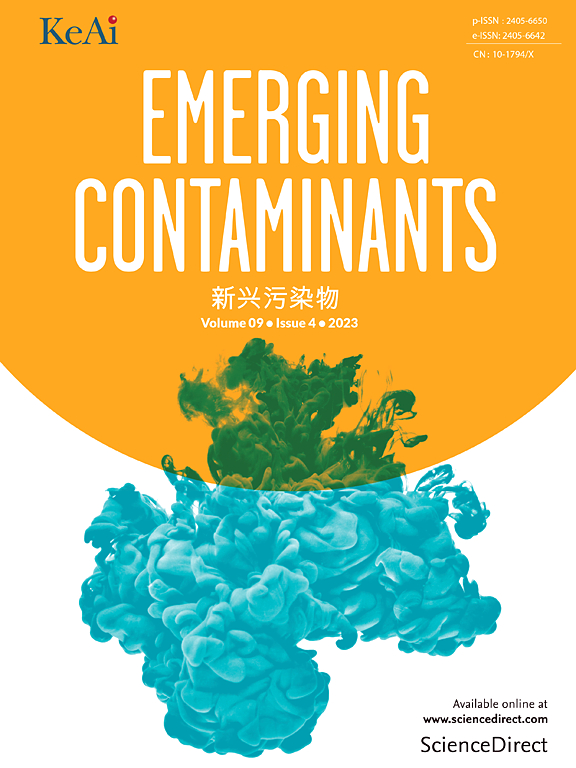Occurrence and risk assessment of per- and polyfluoroalkyl substances (PFASs) in water, sediment, soil, and moss: An environmental media study in Caohai, China
IF 6.9
2区 环境科学与生态学
Q1 ENVIRONMENTAL SCIENCES
引用次数: 0
Abstract
Per- and polyfluoroalkyl compounds, also known as "forever chemicals", are ubiquitous in the environment and harm human health. Developing safer, eco-friendly alternatives is vital, but new compounds may cause new issues. Enhanced monitoring and risk assessment are essential. In this study, the detection of PFASs in environmental media, including lake surface water, bottom sediment, soil, and bryophytes, was accomplished by instrumentation in the Caohai region. Subsequently, their distribution characteristics and ecological risks were scientifically analyzed and evaluated. The results showed that new and traditional PFASs were widely found in Caohai, a non-industrial area, and showed obvious short-chain and new PFAS substitution effects. The total concentrations of PFASs (ΣPFASs) in surface water and sediment were measured at 39.55–67.64 ng/L and 2.36–11.55 ng/g dry weight (dw), respectively. The concentrations of ΣPFASs in soil and moss ranged from 0.39 to 1.31 ng/g dw and from 8.90 to 18.07 ng/g dw, respectively. Notably, PFBA and F-53B emerged as the most prevalent PFAS compounds in this region. The calculated risk quotients (RQs) for PFASs are less than 0.01, indicating no significant environmental risk. However, the long-term cumulative risk cannot be ignored, and the ecological protection of Caohai still needs to be paid attention to. The results of this study can help understand the pollution level of PFASs in the wetland water system in plateau areas and provide data references for environmental control such as PFASs pollution protection and ecological management in Caohai.

草海水体、沉积物、土壤和苔藓中全氟烷基和多氟烷基物质(PFASs)的发生和风险评估:一项环境介质研究
全氟和多氟烷基化合物,也被称为“永远的化学品”,在环境中无处不在,危害人类健康。开发更安全、环保的替代品至关重要,但新的化合物可能会引发新的问题。加强监测和风险评估至关重要。本研究利用仪器对草海地区湖泊地表水、底泥、土壤和苔藓植物等环境介质中全氟辛烷磺酸的含量进行了检测。在此基础上,对其分布特征和生态风险进行了科学分析和评价。结果表明,草海非工业地区新型PFAS和传统PFAS广泛存在,并表现出明显的短链替代效应和新型PFAS替代效应。地表水和沉积物中PFASs总浓度(ΣPFASs)分别为39.55 ~ 67.64 ng/L和2.36 ~ 11.55 ng/g干重(dw)。ΣPFASs在土壤和苔藓中的浓度分别为0.39 ~ 1.31 ng/g dw和8.90 ~ 18.07 ng/g dw。值得注意的是,PFBA和F-53B成为该地区最普遍的PFAS化合物。PFASs的计算风险商(RQs)均小于0.01,无显著环境风险。但长期累积风险不容忽视,草海生态保护仍需重视。本研究结果有助于了解高原地区湿地水系中全氟辛烷的污染程度,为草海地区全氟辛烷污染保护和生态管理等环境治理提供数据参考。
本文章由计算机程序翻译,如有差异,请以英文原文为准。
求助全文
约1分钟内获得全文
求助全文
来源期刊

Emerging Contaminants
Medicine-Public Health, Environmental and Occupational Health
CiteScore
10.00
自引率
6.70%
发文量
35
审稿时长
44 days
期刊介绍:
Emerging Contaminants is an outlet for world-leading research addressing problems associated with environmental contamination caused by emerging contaminants and their solutions. Emerging contaminants are defined as chemicals that are not currently (or have been only recently) regulated and about which there exist concerns regarding their impact on human or ecological health. Examples of emerging contaminants include disinfection by-products, pharmaceutical and personal care products, persistent organic chemicals, and mercury etc. as well as their degradation products. We encourage papers addressing science that facilitates greater understanding of the nature, extent, and impacts of the presence of emerging contaminants in the environment; technology that exploits original principles to reduce and control their environmental presence; as well as the development, implementation and efficacy of national and international policies to protect human health and the environment from emerging contaminants.
 求助内容:
求助内容: 应助结果提醒方式:
应助结果提醒方式:


